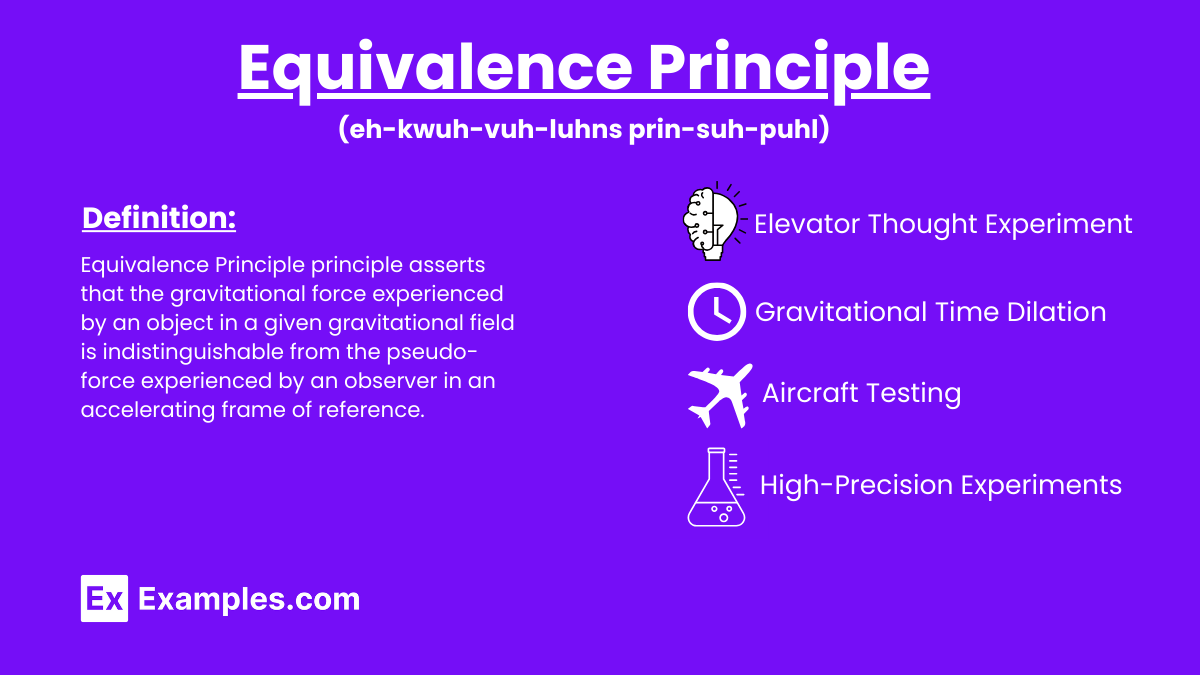What does the Equivalence Principle in general relativity state?
Inertial and gravitational masses are different
Inertial and gravitational masses are the same
Only gravitational mass exists
Only inertial mass exists


The Equivalence Principle is a fundamental concept in the realm of physics that plays a crucial role in the theory of general relativity, formulated by Albert Einstein. This principle asserts that the gravitational force experienced by an object in a given gravitational field is indistinguishable from the pseudo-force experienced by an observer in an accelerating frame of reference. At the core of this principle are the fundamental laws of physics. Which dictate that the outcomes of any local non-gravitational experiment. In a freely falling laboratory are identical to those observed in a laboratory in unaccelerated motion in space free from gravitational fields.
The Equivalence Principle is a foundational concept in physics, especially important in the development of Albert Einstein theory of general relativity. Its history stretches back to early scientific explorations of gravity and acceleration.
The concept began to take shape with Galileo Galilei’s legendary experiments in the late 16th century. Contradicting the prevailing Aristotelian belief that heavier objects fall faster, Galileo showed through his experiments. Notably the reputed dropping of two spheres of different masses from the Leaning Tower of Pisa, that all objects fall at the same rate regardless of their mass, assuming no air resistance. This observation suggested a fundamental equivalence between gravitational mass. (The mass that determines the gravitational force on an object) and inertial mass (the mass that resists acceleration).
Effective mass is a concept in physics that describes the inertia of a particle, such as an electron, moving through a periodic potential, such as the crystal lattice of a semiconductor. This measure reflects how the particle behaves under the influence of external forces, particularly electric and magnet fields, compared to a free particle in vacuum.
Mass is a property of any physical object; it is a measure of resistance to acceleration in the presence of external force. Effective mass is the method used in the general theory of relativity, which talks about gravitational and inertial mass.
The tendency of a massive object to attract each other. Gravitational force between two bodies is given by equation (1):

Where:
Resistance offered by the body against the change in its current state of motion. Force involved here is given by equation (2):
Where:
Principle of equivalence comes up with an idea, saying equation (1) and (2) are the same. That is:

Thus,

On re arrange the above equation we get:

This formula highlights the relationship between gravitational mass and inertial mass, emphasize their equivalent as stated in the general theory of relativity. It also encapsulates how effective mass plays a critical role in understanding the behavior of objects under both gravitational and inertial forces.

The Equivalence Principle, fundamental to Einstein’s theory of general relativity, has various practical and theoretical applications:
It underpins general relativity by demonstrate that gravity is not a force but the curvature of spacetime due to mass and energy.
Einstein imagined an elevator in space accelerate upward. To an inside observer, the effects mimic gravitational forces, illustrating the Equivalence Principle.
The principle suggests that light bends in a gravitational field just as it would change direction in an accelerating frame, showing gravity’s effect on light.
Yes, through experiments like torsion balance tests or measuring gravitational time dilation, researchers test the principle’s predictions against observe effects.
GPS satellites must account for gravitational time dilation, predicted by the Equivalence Principle, to maintain accuracy in their keeping and positioning.
It states that all objects in free-fall experience the same acceleration, regardless of their mass, due to the indistinguishability of gravitational and inertial mass.
It helps explain phenomena like black holes and gravitational waves, where extreme gravitational fields play a critical role.
Special aircraft perform parabolic flights that create short periods of weightless, simulating the effects of being in a free-falling elevator.
Future research aims to probe deeper into quantum gravity and test the limits of general relativity by investigating potential violations of the Equivalence Principle.
The Weak Equivalence Principle asserts the universality of free fall, while the Strong Equivalence Principle includes the equivalence of gravitational and inertial mass.
Text prompt
Add Tone
10 Examples of Public speaking
20 Examples of Gas lighting
What does the Equivalence Principle in general relativity state?
Inertial and gravitational masses are different
Inertial and gravitational masses are the same
Only gravitational mass exists
Only inertial mass exists
Who formulated the Equivalence Principle?
Isaac Newton
Albert Einstein
Galileo Galilei
Niels Bohr
Which experiment is closely related to the Equivalence Principle?
Eotvos experiment
Michelson-Morley experiment
Rutherford gold foil experiment
Young's double-slit experiment
The Equivalence Principle is a key concept in which theory?
Special Relativity
Quantum Mechanics
General Relativity
Classical Mechanics
What does the Weak Equivalence Principle assert?
All objects fall at the same rate in a gravitational field
Gravitational force is proportional to mass
Gravitational and inertial masses are proportional
Gravitational force acts at a distance
What is a consequence of the Equivalence Principle in an accelerating elevator?
Time dilation occurs
Light bends
Objects appear weightless
Length contraction occurs
According to the Equivalence Principle, what is the effect of gravity on light?
Light is unaffected by gravity
Light slows down in a gravitational field
Light bends in a gravitational field
Light speeds up in a gravitational field
Which principle states that local effects of motion in a curved spacetime are indistinguishable from those in a uniformly accelerating frame?
Strong Equivalence Principle
Weak Equivalence Principle
Inertial Principle
Mach's Principle
What phenomenon is explained by the Equivalence Principle?
Compton scattering
Photoelectric effect
Blackbody radiation
Gravitational lensing
How does the Equivalence Principle relate to free fall?
Objects in free fall accelerate differently
Free fall is indistinguishable from inertial motion
Free fall involves constant velocity
Free fall is unrelated to gravity
Before you leave, take our quick quiz to enhance your learning!

